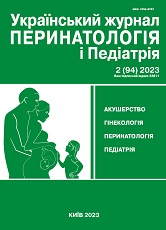Characteristic of epigenetic factors of COVID-19 of fertile aged women residents of the Kharkiv region of Ukraine who have undergone coronavirus infection
DOI:
https://doi.org/10.15574/PP.2023.94.65Keywords:
epigenetic factors, women, fertile age, risk factors, coronavirus diseaseAbstract
Purpose - to characterize the epigenetic factors of COVID-19 in women of childbearing age, residents of Kharkiv region who have had coronavirus infection, identified as a result of clinical and epidemiological studies.
Materials and methods. This research investigates the potential epigenetic risk factors for COVID-19 onset and progression in women of childbearing age in the Kharkiv region. An original, comprehensive questionnaire designed to capture a wide range of health and socio-biological risk factors was disseminated among 100 women who had contracted the virus. Follow-up examinations and interviews were conducted with 26 of these women. The questionnaire covered a broad spectrum, including general information, social status, working conditions, smoking and alcohol use habits, sexual health history, and a interview.
Results. The study revealed that a notable proportion of the surveyed women experienced adverse working conditions. 7.7% reported regular and 11.5% occasional exposure to chemically harmful environments. About 19.2% indicated consistent and 34.6% intermittent work-related nervous strain. Furthermore, 7.7% of the respondents identified persistent physical hazards at their workplace, while 23.1% experienced occupational harm. Among male partners, 3.8% always and 23.1% occasionally had contact with harmful vapours or chemicals at work. Epigenetic risk factors were determined using a clinical genealogical map. Occupational harm was absent before and after COVID-19 infection in 19.2% and 15.4% of women, respectively. Regarding harmful habits, 26.9% and 23.1% of women did not engage in tobacco smoking before and after COVID-19 infection, respectively, whereas 3.8% and 7.7% consumed alcohol. Past illnesses, such as rubella and Botkin's disease, were identified as potential epigenetic factors in 3.8% of women.
Conclusions. It has been established that among the identified epigenetic risk factors that may directly or indirectly affect the spread of coronavirus infection in women residents of the Kharkiv region, the following require special attention of the doctor: contact with physical and chemical agents, past diseases and conditions, and bad habits, which may be important for the spread of the disease in women. It has been found that among the epigenetic factors of COVID-19, past illnesses and conditions are important - rubella was experienced by 3.8% of women before COVID-19, Botkin’s disease - 3.8%, and 3.8% of women before and after the disease.
The research was carried out in accordance with the principles of the Helsinki Declaration. The study protocol was approved by the Local Ethics Committee of the participating institution. The informed consent of the patient was obtained for conducting the studies.
No conflict of interests was declared by the authors.
References
CDC. (2019). Coronavirus (COVID-19). URL: https://www.cdc.gov/coronavirus/2019-ncov/index.html; (accessed on 18/06/2020).
Chen N, Zhou M, Dong X et al. (2020, Feb 15). Epidemiological and clinical characteristics of 99 cases of 2019 novel coronavirus pneumonia in Wuhan, China:a descriptive study. Lancet. 395 (10223): 507-513. https://doi.org/10.1016/S2215-0366(20)30078-X; PMid:32085839
Froidure A, Mahieu M, Hoton D, Laterre P-F et al. (2020). Short telomeres increase the risk of severe COVID-19. Aging. 12: 19911-19922. https://doi.org/10.18632/aging.104097; PMid:33104521 PMCid:PMC7655194
Livshyts LA, Harashchenko TA, Umanets TR, Krasnienkov DS ta insh. (2021). Vzaiemozv'iazok mizh rozpovsiudzhenistiu henotypu II za polimorfizmom ACE1 I/D ta zakhvoriuvanistiu i smertnistiu na COVID-19 v krainakh Yevropy. Cytology and Genetics. 55; 5: 427-432. ISSN 0095-4527. https://doi.org/10.3103/S0095452721050054; PMid:34565928 PMCid:PMC8450713
Oronsky B, Larson C, Hammond TC, Oronsky A et al. (2021). A Reviewof Persistent Post-COVID Syndrome (PPCS). Clin. Rev. AllergyImmunol: 1-9. https://doi.org/10.1007/s12016-021-08848-3; PMid:33609255 PMCid:PMC7896544
Podolskyi VV, Antipkin YG, Podolskyi VlV, Umanets TR, Kaminska TM, Livshyts LA, Rudenko SA. (2021). Medico-social factors of the possibility of the spread of coronavirus infection among women of childbearing age. Reproductive endocrinology. 5 (61): 8-15. https://doi.org/10.18370/2309-4117.2021.61.8-14
Rudrapal M, Khairnar SJ, Borse LB, Jadhav AG. (2020, Sep). Coronavirus Disease-2019 (COVID-19): An Updated Review. Drug Res (Stuttg). 70 (9): 389-400. Epub 2020 Aug 3. https://doi.org/10.1055/a-1217-2397; PMid:32746481 PMCid:PMC7516369
Singhal TA. (2020, Apr). Review of Coronavirus Disease-2019 (COVID-19). Indian J Pediatr. 87 (4): 281-286. https://doi.org/10.1007/s12098-020-03263-6; PMid:32166607 PMCid:PMC7090728
Smyrnov VV, Leonov HE. (2016). Epyhenetyka: teoretycheskye aspektы y praktycheskoe znachenye. Lechashchyi vrach: 12.
Tran K, Cimon K, Severn M, Pessoa-Silva CL, Conly J. (2012). Aerosol generating procedures and risk of transmission of acute respiratory infections to :healthcare workers: a systematic review. PLoS One. 7 (4): e35797. https://doi.org/10.1371/journal.pone.0035797; PMid:22563403 PMCid:PMC3338532
Velavan TP, Meyer CG. (2020, Mar). The COVID-19 epidemic Trop Med Int Health. 25 (30): 278-280. https://doi.org/10.1111/tmi.13383; PMid:32052514 PMCid:PMC7169770
Walitt B, Bartrum E. (2021). A clinical primer for the expected and potential post-COVID-19 syndromes. Pain Rep. 6: 1-7. https://doi.org/10.1097/PR9.0000000000000887; PMid:33615088 PMCid:PMC7889402
Xu Y, Li X, Zhu B et al. (2020). Characteristics of pediatric SARS-CoV-2 infection and potential evidence for persistent fecal viral shedding. Nat Med. 26 (4): 502-505. Epub 2020 Mar 13. https://doi.org/10.1038/s41591-020-0817-4; PMid:32284613 PMCid:PMC7095102
Zhu N, Zhang D, Wang W, Li X, Yang B, Song J et al. (2020, Feb 20). A novel Coronavirus from patients with Pneumonia in China, 2019. N Engl J Med. 382 (8): 727-733. https://doi.org/10.1056/NEJMoa2001017; PMid:31978945 PMCid:PMC7092803
Downloads
Published
Issue
Section
License
Copyright (c) 2023 Ukrainian Journal of Perinatology and Pediatrics

This work is licensed under a Creative Commons Attribution-NonCommercial 4.0 International License.
The policy of the Journal “Ukrainian Journal of Perinatology and Pediatrics” is compatible with the vast majority of funders' of open access and self-archiving policies. The journal provides immediate open access route being convinced that everyone – not only scientists - can benefit from research results, and publishes articles exclusively under open access distribution, with a Creative Commons Attribution-Noncommercial 4.0 international license(СС BY-NC).
Authors transfer the copyright to the Journal “MODERN PEDIATRICS. UKRAINE” when the manuscript is accepted for publication. Authors declare that this manuscript has not been published nor is under simultaneous consideration for publication elsewhere. After publication, the articles become freely available on-line to the public.
Readers have the right to use, distribute, and reproduce articles in any medium, provided the articles and the journal are properly cited.
The use of published materials for commercial purposes is strongly prohibited.

